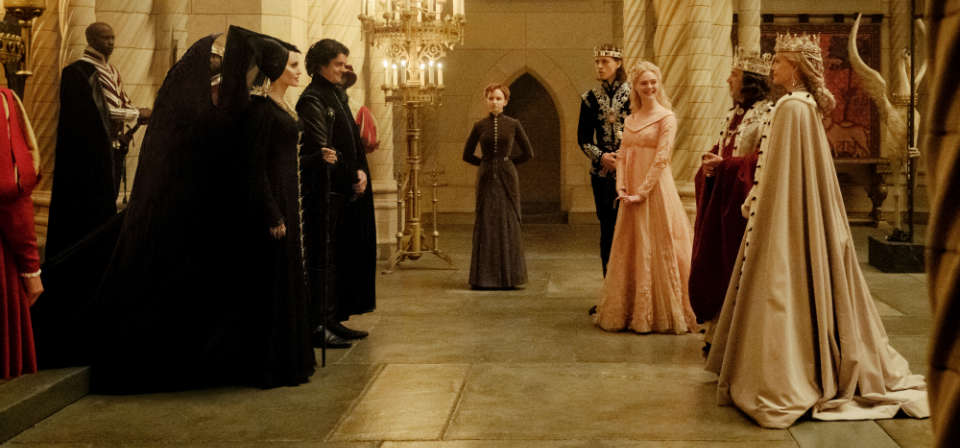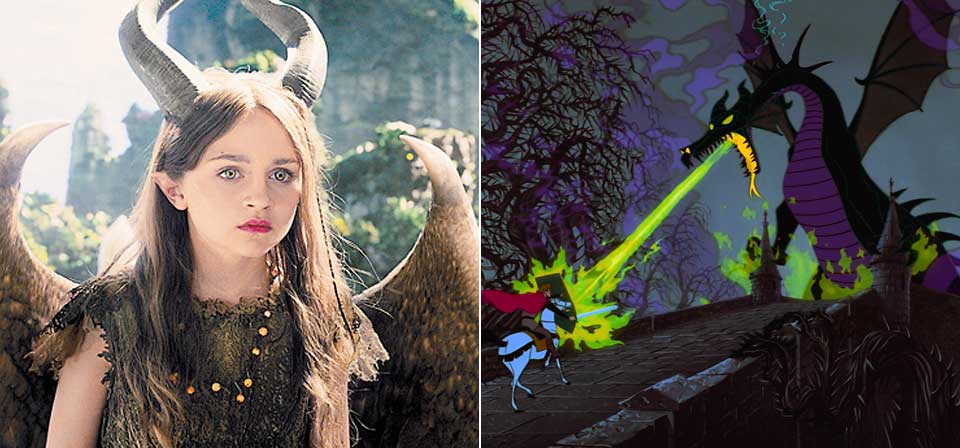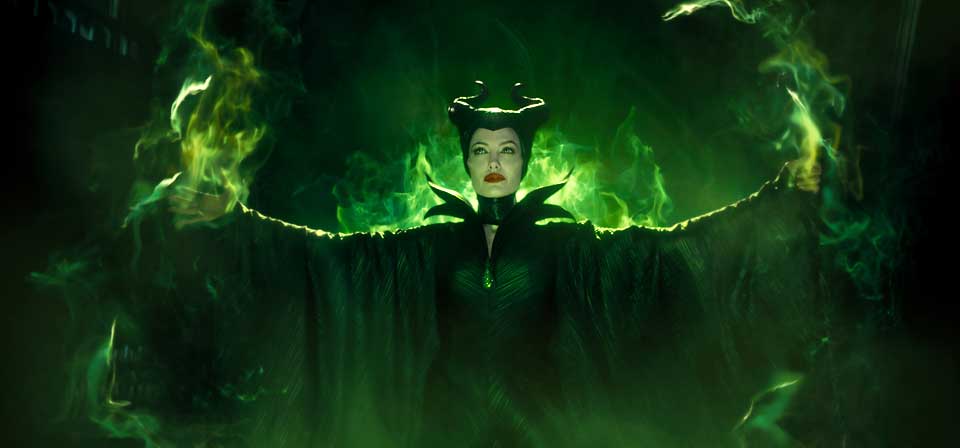Maleficent (2014)
Stop me if you’ve heard this one (or if you don’t want to be spoiled on the film, which I think you probably should be).
Caveat Spectator
Fantasy action violence and some disturbing images.This revisionist take on a classic fairy tale gives us not one but two heroines, who share a special bond: an older one with magical powers and a young princess innocently devoted to the first.
At times their relationship is strained; the older one — an archetypal witch-villainess in the traditional story, though she’s rehabilitated here — even smites the young princess with her powers, dooming her to eventually fall into a deathlike state.
The young princess grows up isolated and alone due to her parents’ efforts to protect her from the other heroine’s powers. Meanwhile, the witchy heroine, rejected by society, withdraws to barren wastelands and uses her power over nature to surround herself with nearly impenetrable boundaries on all sides. (She also creates a magical sidekick, a nonhuman character given the powers of human speech and thought.)
There’s a cute but irrelevant male love interest, and some noise about true love’s kiss, and how he might save the stricken heroine from her deathlike fate — but, no, he’s ultimately useless. Only girl power can save the day!
Finally, there’s the real villain: a royal, patriarchal figure who should be a good guy but isn’t — who cynically uses the girlish romantic affection of one of the heroines against her, plotting to kill her to seize the throne. In a climactic conflict, he sneaks up behind the magical heroine with a drawn blade and tries to strike her down by surprise.
Sound familiar?
It’s fair to say that Disney’s Maleficent plays to an extent as warmed-over Frozen. This is not a good thing, even, I think, if you are a fan of Frozen. (I wasn’t a fan of Frozen, though I didn’t hate it either.) Certainly Frozen is superior to Maleficent, the latest dark, subversive live-action retelling of a classic fairy tale — in this case, Sleeping Beauty, as told in the classic 1959 Disney cartoon (the one Disney fairy tale between Pinocchio and Beauty and the Beast that approaches greatness).
Practically every character in Frozen is more interesting than anyone in Maleficent, though the latter has one great asset towering above its defects: Angelina Jolie as the title character. What Johnny Depp couldn’t do in Alice in Wonderland, Charlize Theron couldn’t do in Snow White and the Huntsman and nobody in Oz the Great and Powerful could do, Jolie does here: Through sheer charisma, she makes the film watchable when nothing else does.
Alas, Jolie is only allowed to play the iconic title character in any way approaching the figure we know from Sleeping Beauty in one sequence: the nominal christening scene in which the good fairies give the newborn princess Aurora their gifts, and Maleficent curses her to prick her finger on the spindle of a spinning wheel before the sun sets on her 16th birthday and die — or, as the curse runs here, to fall into an eternal sleep from which only true love’s kiss will awaken her.
You might be thinking: Isn’t that bit about the bit about eternal sleep and true love’s kiss the third good fairy’s mitigation of Maleficent’s curse of death? That’s the way it runs in the canonical story, yes. Here, though, although the third fairy is interrupted from giving her gift by Maleficent’s arrival, just as in the canonical story, the film never bothers to get back to the third fairy’s gift.
You see, the good fairies (Imelda Staunton, Juno Temple and Leslie Manville, all wasted) are irrelevant, impotent and ridiculous. That’s because they’re complicit tools of the patriarchy, which robs women of their power.
If you think I’m exaggerating, consider the opening act, in which Maleficent is left maimed and traumatized when her childhood sweetheart lulls her to sleep before hacking off her powerful wings — a metaphorical rape, or perhaps genital mutilation (against which Jolie has been a public campaigner). Either way, a pretty dark subtext for a PG movie.
Why does he do that? Because he happens to be Aurora’s royal father-to-be Stefan (Sharlto Copley), and Maleficent’s wings are his ticket to ensure his succession from the previous king, who is dying from an ill-fated battle against Maleficent and her fellow magical creatures who live on the Moors.
Why did the previous king make war against the denizens of the Moors? Well, because that’s what ignorant, hate-filled patriarchal brutes do, of course: attack whatever is different from them, whatever they don’t understand. Also, greed, since we’re told the Moors have great treasures. Bottom line: Humans are rotten, especially men, while magical earth creatures are good and live in harmony with one another.
Welcome to another aggrieved feminist fairy tale brought to you by screenwriter Linda Woolverton, who also wrote Alice in Wonderland — another film I didn’t care for but prefer to this one. (First-time director Robert Stromberg was a visual-effects artist on Alice, Oz the Great and Powerful and Avatar; this film looks like a generic mashup of those with no distinctive visual signature of its own.)
Before Stefan’s treachery, Maleficent was a good fairy, despite having devil horns and an obviously evil adjectival name meaning the opposite of “beneficent.” I have no objection to Maleficent starting out good, but she should have had a different name initially, like Satan originally being called Lucifer.
Now Maleficent (I’ll call her M for short) has become a bitter soul who no longer believes in true love, which is why she places the seemingly merciful clause into the curse on the princess. It’s M’s way of punishing Stefan for his treachery, you see. I’m not sure I want to live in a cinematic universe in which horse-faced Sharlto Copley can rock Angelina Jolie’s world that badly, but there it is.
As royal villains go, Stefan is far less interesting and compelling than Frozen’s Hans, who was handsome, brave, charismatic and could carry a tune. Hans was probably originally written as a hero, and could have been Disney’s most compelling heroic male character ever — certainly since the original Prince Philip in Sleeping Beauty — had it not been necessary to turn him at the last minute into a villain to compensate for the decision to make Elsa a heroine rather than a complex villainess.
Maleficent’s Prince Philip (Brenton Thwaites), although a perfectly nice guy from what little we see of him, may be the most irrelevant love interest in Hollywood fairy-tale history. To say he doesn’t hold a candle to Frozen’s Kristoff would be an understatement. Kristoff actually saves Anna’s life at one point; Philip does nil. (Someone, not M, does transform into a dragon at the climax, but if you’re hoping to see Philip battle it, you’ll be sadly disappointed. Needless to say, it’s a good dragon.)
After one brief, unremarkable exchange with Aurora in the forest, Philip spends most of his time in an enchanted sleep, with M levitating him around like a comical prop, not unlike the corpse in Weekend at Bernie’s.
In the classic version, Maleficent kidnaps Philip to prevent the kiss of true love from awakening Aurora. Here, she kidnaps him in order to bring him to the castle in the hope that he can awaken her, which, of course, he can’t. Not that it matters much; Aurora is asleep so briefly they should have called her Napping Beauty.
You see, after cursing the newborn princess, M quickly gets over her brief bout of sheer evil, lapsing instead into ironic cynicism. In this version, not only does M keep track of Aurora at all times, she’s actually the one keeping her alive despite the bumblings of the three incompetent “good” fairies.
You might think M is keeping Aurora alive in order to let the curse play out. However, meaningful croaks from her raven ally Diablo — or Diaval, as he introduces himself here when Maleficent turns him into a human (Sam Riley) in order to save him from some mean people protecting their crops — are clearly meant to suggest that the supposed queen of darkness is going soft on the girl.
When M actually meets the 15-year-old Aurora (Elle Fanning, managing the preternatural winsomeness Kristen Stewart’s Snow White lacked), she’s quickly won over by the latter’s goodness and sweetness. Aurora, correctly recognizing M as the protective presence hovering over her since infancy, actually calls her “my fairy godmother.” Pretty soon, M is regretting ever cursing the girl over what was, after all, a grudge against the father; she even tries to revoke the enchantment, but alas, she made it too strong.
And so the story grinds on to the bitter end, in which the power of evil patriarchy is broken, sisterhood lives happily ever after, and Prince Philip grins stupidly, because he has no reason to be here, really.
Strangely, despite the film’s feminist leanings, Aurora herself is a passive princess of the old-school type, whose most subversive act is loving the title character.
Is it too much to hope that someday Hollywood will make fairy tales with strong, admirable heroines and strong, admirable heroes? Maybe, too, just to mix things up, the traditional villains can be evil again, someday.
Related

Maleficent: Mistress of Evil (2019)
It’s tempting to suppose that Maleficent: Mistress of Evil opening in the wake of Columbus Day isn’t a coincidence.

How Disney’s Maleficent subverts the Christian symbolism of Sleeping Beauty
Give me princesses like Leia from Star Wars, Merida from Brave or Tiana from The Princess and the Frog any day. But there’s a difference between creative revisionism and simple inversion.

Maleficent, Rape and Sympathy for the Devil
A story like this demands to be seen through the lens of what biblical scholars call “redaction criticism,” which basically means “What was changed, added or deleted in this retelling of the story, and what do those changes tell us about the storyteller’s intentions and outlook?”
![Maleficent [video]](/uploads/articles/maleficent.jpg)
Maleficent [video] (2014)
Angelina Jolie is perfect for the part of Disney’s most iconically evil villainess. If only they’d let her play it for more than one scene.
Recent
Home Video
Copyright © 2000–2025 Steven D. Greydanus. All rights reserved.